In the 21st century, we can’t imagine our life without the Internet. Whether we need information like the weather forecast or funny videos with cats, the answer is the same – open the web. According to Statista, we surf digital waves for up to 147 minutes a day. This amount grows year by year: in 2021, the average surfing time was 145 minutes.
Contents:
When an enormous structure like the Internet transforms, no doubt it will stir up our lives as well. We experienced drastic changes in our everyday routine during previous Web transitions. The experts say the next stage should start in the near future, so, if you want to be its pioneer, you better get ready today.
So how can you be ahead of the game and what to expect? In this article, we will dwell a bit on Web history since it will help us understand the upcoming changes better. Also, we’ve wrapped up various predictions on Web 3.0 that will help you get a grasp of it.
Web History Course: From 1.0 To 3.0
What’s the Web in general? It is a concept that defines general rules: how the websites work, how the users get or produce content, what means are involved during these processes, etc. This approach emerged when experts compared 2.0 with the previous version 1.0, and the Internet changes we experience now.
Web 1.0: Origins Of the Internet
The first stage or Web 1.0, started all the way back in the 90s when popular Internet browsers like Mosaic and Explorer came to the market. We can describe this period as “Read-Only” since the user could not publish any content. Imagine a giant library where you can find a necessary book, read it, but do nothing more – that’s Web 1.0.
As for the website design, it wasn’t appealing to users and served only as means to get the necessary info. What’s more, the websites were not adaptive and worked correctly only with the browsers they were made for. Overall, this period lasted from 1991 till 2004.
Web 1.0 key features:
- Read-only websites
- Unappealing design and looks
- Users did not participate in the content creation
In 2005, Tim O’Reilly, the founder of O’Reilly Media, described how the Internet changed since the 90s. He called the new version Web 2.0 and highlighted the contrasts in comparison with the 1.0 version. By the way, we are still living in the Web 2.0 epoch, so we can clearly see how the Internet has changed and how it has changed our lives too.
Web 2.0: Present Time Of The Internet
In Web 2.0, regular users can finally publish their own content on the Internet, that’s why this period is described as “Read/Write Web”. Remember how we compared the Internet with the library? In library 2.0, you can not only take and read the book, but place your own creations on its shelves, and share them with other visitors.
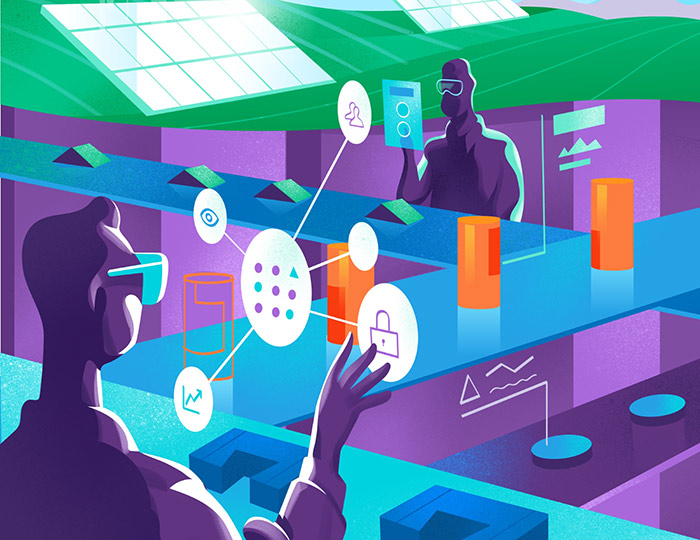
Illustration by Hurca!
Thanks to easy authorization, people can create accounts on almost any website and start making personal content. They give their private data in return, and this allows companies to thrive on ads and personal recommendations for their users. If you and your friend open YouTube, the videos on its main page will differ based on preferences.
The UI\UX design has changed too thanks to the mobiles and tablets. It has become adaptive, so you can watch cat videos both on your phone and PC. Now the website’s aim is not only information delivery. The web design has to please the eye of the user and give them a nudge to do things necessary for the company.
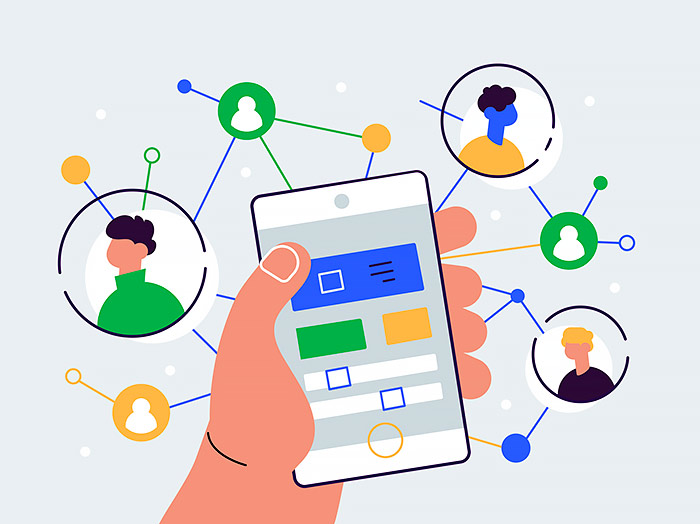
Social network illustration by Serj Marco
Driven by social media, people started to interact not only with the website content but with each other as well. We give likes on Instagram, share funny videos with friends, call taxis via Uber, and send messages on WhatsApp. We order food, buy wares, plan trips, watch movies – the list of things people do via the Internet can go on and on.
People send more than 100 billion texts each day on WhatsApp
Web 2.0 key features:
- Read/Write websites
- Users publish their own content but do not own it
- The era of target ads and recommendations
- Private user data is a “currency” for ad companies
- Growth of social media
Now that we know the history of the Web and its versions, let’s move on to the 3.0 stage.
Definition Of Web 3.0: Known Features, Pros & Cons
Although no one really has a distinct image of Web 3.0 yet, some people share their views on the subject.
Jason Calacanis, American serial entrepreneur, and general manager of Netscape was the first one to describe 3.0. He thinks we will return to the good old times of Web 1.0 when the content belonged to the ones who produced it.
Tim O’Reilly supported Jason’s ideas. He also mentioned that Web 3.0 should be a leap forward and break the Internet standards, connecting the digital world with reality.
Web 3.0 is defined by three things: decentralization, edge computing, and AI.
Decentralization means that all the data will not be stored on single company servers but divided between all the users. The same technology lies in modern blockchain and torrent systems. People have their own pieces of data that they can sell or barter for another data piece.
When we compare Web 3.0 vs Web 2.0, the ownership here belongs to the user, not to the company that provides the web platform. There are no third parties and the user’s private data is not at risk.
Decentralized Autonomous Organisations (DAO), decentralized apps (dApps), and services that provide global data transfer already exist, but they are not connected. However, the Web 3.0 development based on DAO is constantly growing. It’s a lucrative area for investment, project application, or a field to specialize in — if you are a skilled web developer.
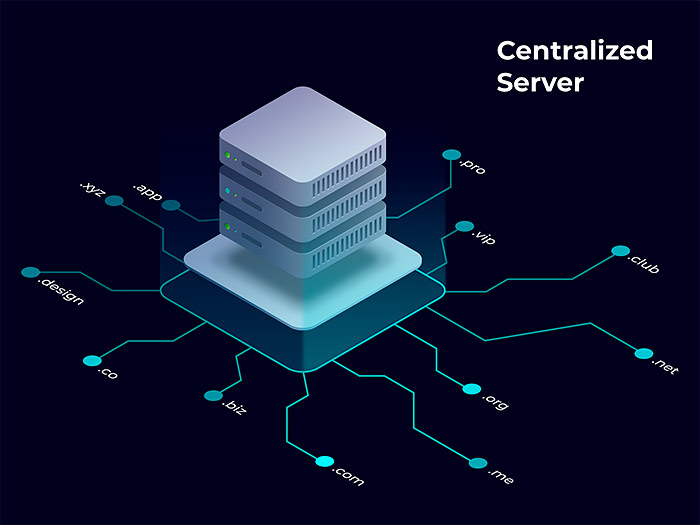
Centralized Server by Aleksey Popov
Edge computing is kind of similar to decentralization. The data centers will slowly move to the outskirts. They will be supported by millions of small data centers located on our devices. It can be smartphones, vehicles, computers, etc. In today’s Web 2.0, all the data is stored in single centers and provided to you only on request.
Artificial Intelligence will play one of the main roles in the Web 3.0 era. With smart algorithms, businesses will be able to make cutting-edge apps aimed not at target advertisements but at helping users.
In the future, machines can drastically improve search results using a semantic web. The key here is different relations between things: object – connection type – another object. As a result, you will find web pages with necessary info quicker.
Since the Internet will be decentralized, it will become open and clear to regular people. Society will oversee the content and regulate its publishing. That means, no government censorship.
Web 3.0 has a few downsides. Most of its technologies are very expensive and require long-term implementation. Those who can’t afford them will lose the beat and simply vanish.
Others will have to spend lots of time and money on modernization since Web 3.0 technologies are very picky about performance.
Internet decentralization will lead to high cybercrime rates because it’ll be much harder to track hackers. Users’ private data may be even more vulnerable than it is now.
Web 3.0 will probably have the following features:
- Internet decentralization
- Rise of AI and smart algorithms
- Data centers will move to the system edge
- No third-parties, peer-to-peer communication
- Users will publish and own their content
- No censorship: society will become a moderator
We discussed Web 3.0 and its possible features. Now let’s see how they will transform the Internet we know today, and how businesses can use them to their advantage.
Changes That Web 3.0 Might Bring Into Our Life
We are still reading tea leaves, however, there are a few things that may become absolutely normal even tomorrow. We gathered predictions on Web 3.0 trends from various experts and wrapped them up for you.
NFT, or Non-Fungible Tokens, and blockchain are starting to hit stride. Serving as the Web 3.0 technology example, they may become a basis for future Internet and economy.
Cryptocurrency will likely replace regular money and eventually, this will lead to radical changes in the banking system. The banks as we know them may disappear. Private organizations will take their place and become independent from the government and its politics.
Even if you’re skeptical about tokens, you’d better start making some research in those fields. 36% of employees already want to receive their salary in cryptocurrency, while 42% choose NFTs as a paycheck.
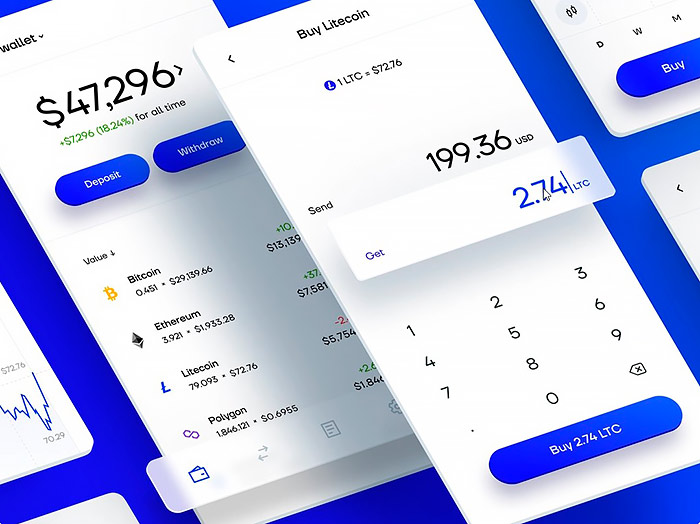
Crypto Trading App Concept by Conceptzilla
If you create content like art, texts, videos, or any other, you can find new ways to earn money with Web 3.0. It allows you to transform your content into tokens and get additional monetization via the NFT marketplaces. These creations will be absolutely unique and have a special mark protecting the copyrights. Your customers or viewers interacting with your art will be able to earn rewards in return.
The most expensive NFT art ever sold is Pak’s ‘The Merge’. In December 2021, during the auction, the picture price hit $91.8 million.
Lots of companies add NFTs and blockchain to their mobile apps. This is not only financial apps but games and art galleries as well. They are extremely popular: Axie Infinity has around 2.7 million daily active users. That’s why mobile app development based on Web 3.0 technology might be a very profitable project.
Metaverses may sound like a cliche from a sci-fi movie, but in reality, they are already here. It’s a so-called 3D Internet where digital algorithms are represented as physical objects in our world. Using a VR headset, a person can enter a digital universe and make different actions: chat with friends, buy or sell something via blockchain companies, visit other people’s universes, etc.
Mark Zuckerberg, the co-founder of Facebook, was the first to launch a metaverse. In summer 2021, he started to transfer the popular social network into a 3D digital world.
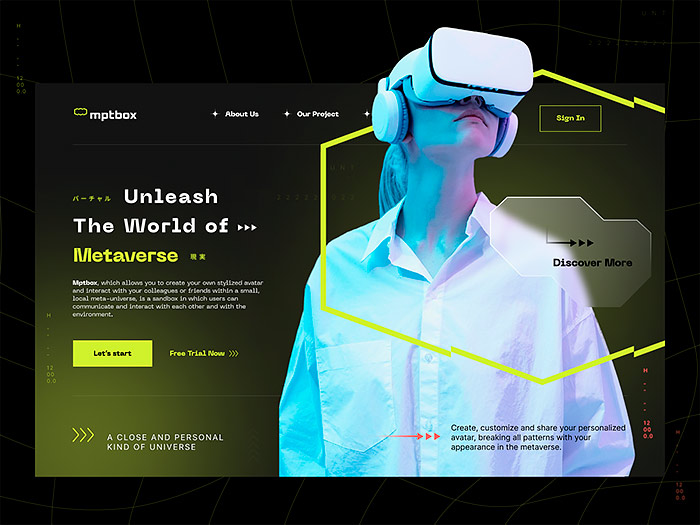
Metaverse website by Phenomenon Studio
Other companies like Epic Games and Microsoft have also started developing metaverses. The number of Web 3.0 virtual worlds users is growing rapidly. In 2021, it reached 50,000 people, which is approximately 10 times more than in 2020. As for the annual income, it is about to reach $10 billion. If these projects succeed, soon the real world will be transformed into a video game.
Metaverses are not just entertainment: they can be used as innovative e-learning platforms. An interactive environment is a perfect way to study languages, arts, sports, etc. That’s why, if you have an idea of creating an e-learning project, you can already consider adding a 3D environment to it and get ahead of your competitors.
Conclusion
The Internet is constantly growing, so the arrival of Web 3.0 is just a matter of time. Right now we can only predict and guess about the upcoming changes in our life.
Since Web 3.0 technologies are hungry for performance, we will likely deal with a hybrid Internet model during the first years of the transfer. Web 2.0 will obtain a few features from Web 3.0 like cryptocurrency or DAO and then continue to change more slowly. This gives us more chances to get ready and stay on top when the radical changes really take place.
If you want to create a ground-breaking idea or make a rebranding according to the upcoming changes, contact our team. We will ensure your project will stay in tune with the time.
